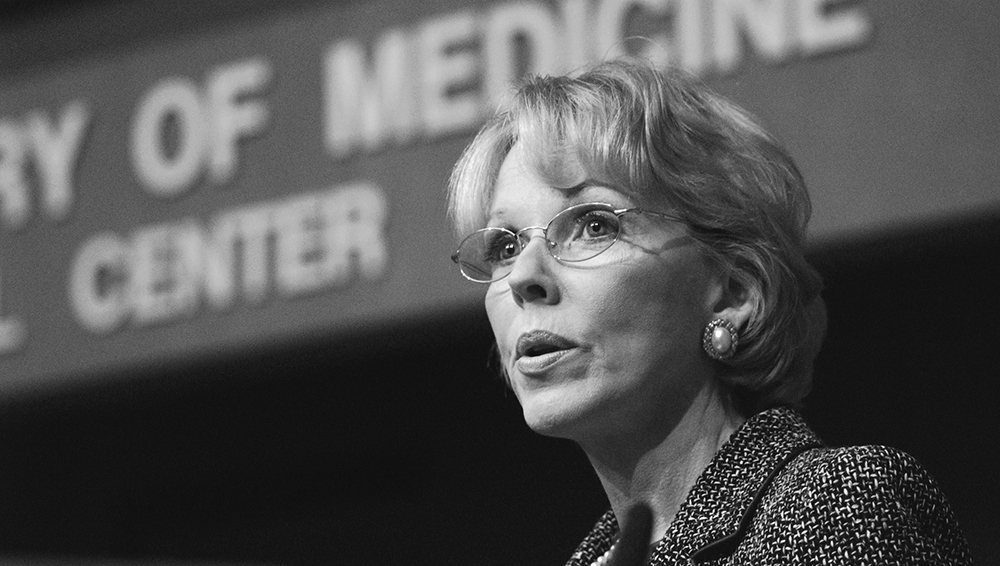Women’s History Month is coming to an end, but our recognition continues. We are so appreciative of the contributions of women who came before us in medicine, science, technology, and data. We hope to carry on the torch with our revolutionary, tech-enabled research model, which not only ensures inclusion of minorities and women in clinical trials, but conducts this medical research at unprecedented speed, scale and affordability.
First Female Director of the NIH

When Dr. Bernadine Healy graduated from Harvard Medical School, she was one of only 10 women in the class of 120 graduates. She then became the first female to become full-time cardiology faculty at Johns Hopkins School of Medicine. She identified how heart attacks present differently in women, a stark contrast to the standards set by men’s symptoms.
As the first woman to be the Director of the National Institute of Health (NIH), she launched the Women’s Health Initiative, known as the “moonwalk for women” that researched cardiovascular disease, osteoporosis, and cancer. A key takeaway from this research was that hormone replacement therapy did not prevent cardiovascular disease for women who were postmenopause, reversing what was commonly prescribed at that time. This finding would save the United States $15.2 billion in direct medical costs.
A strong advocate of including women in clinical trials, Dr. Healy set a policy that the NIH would only provide funding for clinical trials that included both men and women on conditions impacting both genders.
Women in Clinical Trials

Radicle Science’s Pelin Thorogood and Dr. Emily Pauli receive International Stevie Awards for Maverick of the Year and Woman of the Year in Healthcare, respectively.
While the NIH only funds trials with gender parity, the vast majority of other traditional clinical trials continue to study predominantly caucasian males. It thus comes as no surprise that women experience adverse drug reactions at twice the rates of males and in an analysis of prescription drug recalls, 80% were from women experiencing unanticipated side effects. This is why Radicle Science is passionate about intentionally including women in our clinical trials.
Dr. Emily Pauli, our Chief Research Officer, explains, “Traditional clinical studies often lack diversity. Women represent a minority of study participants (with the exception of breast cancer or gynecological issues). Consequently, the results are less generalizable, which is why underrepresented populations, including women, often experience more adverse effects or poor outcomes.
At Radicle Science, we are proud that clinical trials are diverse, closely aligned to the demographics of the US population, with women representing approximately half of the enrolled study participants. Our goal is to assure the results seen for the products studied during a Radicle Science study are applicable to the people that will ultimately use them. It’s real world data with relevance to the real world!”
Dr. Susan Hewlings, our VP of Research Affairs, and Pelin Thorogood, our Executive Chair and Cofounder, shared more with NutraIngredients on how to break the cycle and get data equity in research.
Data & Medical Informatics Pioneers

We recognize historical forerunner Elizebeth Smith, America’s first female cryptanalyst, whose keen ability to recognize data patterns and mastery of code breaking helped to decipher hundreds of Nazi spy ciphers during World War II. In fact, her codebreaking revealed the Nazi spy network across Latin America, an accomplishment for which J. Edgar Hoover took all the credit for the FBI. Yet, it was Elizbaeth who was able to track down this spy network’s ringmaster, Johannes Siegfried Becker, when every other intelligence agency, including the FBI, had failed. In the downing of this spy ring, Chile, Bolivia, and Argentina made the decision to break with the Axis to side with the Allied countries, thus ending the risk of the Western Hemisphere falling. Elizebeth’s keen data analysis is one reason we can still be Americans today.
As passionate healthtech pioneers ourselves, we recognize Dr. Ruth Dayhoff, the forerunner of medical informatics. In the mid-1980s, she was first to integrate medical images with hospital information for clinical databases, which was then deployed by the VA. The implications on patient care were tremendous, allowing physicians to easily access and view medical images – rather than digging through 5 mb disks a foot in diameter or solely relying on written radiology reports. Her vision was the precursor to the Epic EHR system today of electronic patient records.
Today’s Scientists of Accolade

We recognize Dr. Katharina Volz, who first identified the stem cells forming coronary arteries, which are pericytes that become smooth muscle cells as a response to blood flow increases. She was Stanford’s first PhD in stem cell biology and regenerative medicine, and now in partnership with the Stanford AI lab, she is applying machine learning algorithms to mapping data on brain-aging disorders in hopes of curing neurodegenerative diseases. It’s no surprise she was ranked as a “MIT 35 under 35” and “Forbes 30 under 30.” We are very grateful for Dr. Volz’s contribution as a Radicle Science advisor and inspired by her mission to cure the incurable.

We also recognize Fei Fei Li, the Director of the Stanford Artificial Intelligence and Vision Labs and professor at the Computer Science Department at Stanford. Here she works with students around the world to develop algorithms to help robots and computers to “see” and “think” and conduct experiments to better understand human neurology and how human brains see and think.
Since this month celebrates not only women’s achievements, but serves to inspire, we hope you are filled with inspiration for your unique mission! If you’d like to join our mission and volunteer in some of which are history’s largest clinical trials on supplements and natural products, sign up below. You will be amongst the first to be invited to new studies!


